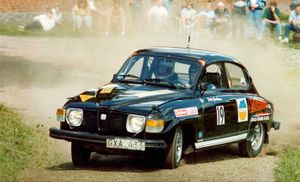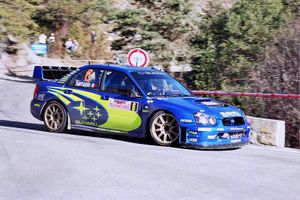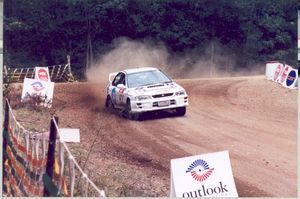| |
Rallying
Car Show
Rallying
Rallying (international) or rally racing (US) is a form
of
automobile racing that takes place on public roads with modified
production or specially built road cars. This unique motorsport is
distinguished by running not on a circuit, but instead in a
point-to-point format where participants and their co-drivers “rally” to
a set of points, leaving in regular intervals from start points. The
entertaining and unpredictable nature of the stages, and the fact that
the vehicles are in some cases closely related to road cars, draws
massive spectator interest, especially in Europe, Asia and Oceania.
History
 A Saab 96 V4 participating in a
historic rally.
A Saab 96 V4 participating in a
historic rally.
While it is almost certain that similar competitions took place almost as
early as there were cars, modern rallying originated in Europe in the early 20th
century, and gained a modest foothold in car-crazy Europe. Not blind to the
growing popularity, auto manufacturers began to support “works” or “factory”
cars and sometimes entire teams in the events scattered around Europe throughout
the year, and eventually a European Championship series was arranged, awarding
points to the top finishers of the various respective events and standardizing
rules. Later to become the
World Rally Championship, this was a large step forward for rallying. There were
negatives, however, as countries with multiple rallies were ultimately forced to
nominate a single event for the regional and later world championship to the
detriment to the other rounds. The movement truly hit its stride after the
Second World War, reaching its romantic “Golden Age” in the 1960’s as the
Post-WW2 baby boom generation began to grow up. Soon after, sponsors’
advertisements began to pock the paint of the rally cars, and the
commercialization that permeates the modern sporting world began to change
rallying forever. Drivers became paid professionals and technology advanced at
shocking speeds, almost totally unhindered until the mid-eighties. The World
Rally Championship now visits nearly all continents, taking its
stylish sideways driving style and specialized cars to a vast global market,
estimated by some to be second only to the
Formula
One juggernaut. This has produced unprecedented levels of visibility in
recent years, but in many ways removed the motorsport from its “grassroots”
past. For better or worse, rally has become a lucrative business.
Rally cars
 Subaru Impreza during
WRC Monte-Carlo Rally 2005
Subaru Impreza during
WRC Monte-Carlo Rally 2005
In the industry-leading
FIA World Rally Championship, the cars used are built to current World Rally Car
specification. Previously Group A and Group B specification machines (very
powerful turbocharged engines in lightweight bodies) were used. Group B cars
were banned in 1986 because of an unacceptable number of deaths and injuries
among drivers and spectators. It is worth noting, though, that due to advances
in technology today's WRC rally cars are actually much faster than those in the
Group B era, due mainly to superior braking technologies; not one Group B record
stage time stands on the world circuit. Deaths are now very rare thanks to
modern safety regulations including the HANS device and improved spectator
control policies, but rallying retains its own particular dangers, as shown by
the death in 2005 of co-driver Michael Park (admittedly the first fatality at the top level in over a
decade).
Rally courses
Rally is also unique in its choice of where and when to race. Rallys take
place on all surfaces and in all conditions, asphalt (tarmac), gravel, or snow
and ice, sometimes more than one in a single rally, depending on the course and
event. Rallies are also run every month of the year, in every climate, bitter
cold to monsoon rain. This contributes to the notion top rally drivers are some
of the best car control experts in the world. Because the drivers don't know
exactly what's ahead, the lower traction available on dirt roads, and the
driving characteristics of small cars, the drivers are much less visibly smooth
than circuit racers, regularly sending the car literally flying over bumps, and
sliding the cars out of corners.
A typical rally course consists of a sequence of relatively short (up to
about 50km {30mi}) timed "special stages" where the actual competition takes
place, and untimed "transport stages" where the rally cars must be driven under
their own power to the next competitive stage within a generous time limit.
Rally cars are thus unlike virtually any other top-line racing cars in that they
retain the ability to run at normal driving speeds, and indeed are registered
for street travel. Some events contain "super special stages" where two
competing cars set off on two parallel tracks (often small enough to fit in a
football stadium), giving the illusion they are circuit racing head to head.
These stages, ridiculed by many purists, seem increasingly popular with event
organizers. Run over a day, a weekend, or more, the winner of the event has the
lowest combined special and super special stage times. Given the short distances
of super special stages compared to the regular special stages and consequent
near-identical times for the frontrunning cars, it is very rare for these
spectator-oriented stages to decide rally results, though it is a well-known
axiom that a team can't win the rally at the super special, but they can
certainly lose it.
Reconnaissance drives
In most rallies, including those of the
World Rally Championship (WRC), drivers are allowed to run on the tracks of the
course before competition. In these reconnaissance drives, the co-drivers, who
sit next to the drivers, write down shorthand notes on how to best drive the
stage. Usually the drivers call out the turns and road conditions for the
co-drivers to write down. These pacenotes
are read aloud through an internal intercom system during the actual race,
allowing the driver to anticipate the upcoming terrain and thus take the course
as fast as possible.
In the past—and until recently in
North
America—most rally courses were not allowed to be scanned prior to the race,
and the co-drivers used maps supplied by the organization. The exact route of
the rally often remained secret until race day. This is changing though, as
rallies throughout North America are now switching to either organizer supplied
"route notes" or to full reconnaissance or "recce". This change has been brought
on in large part due to competitor demand. Recce makes the competition
experience faster, safer, and more satisfying for the entrant.
Notable rallies
 A Subaru Impreza WRX competing in a rally.
A Subaru Impreza WRX competing in a rally.
Acropolis Rally in Greece
Expedition Trophy [1] in Russia from Minsk to Vladivostok
Junior World Rally Championship (JWRC)
Monte Carlo Rally to Monte Carlo, Monaco
Neste Rally Finland in Finland
Corona Rally Mexico in Mexico
Olympus Rally
Paris Dakar Rally (which is actually an offroad endurance race rather than a
rally as described here)
RAC Rally in the UK
Rally of Poland
Rallye des Pharaons in Egypt
Safari Rally
San Remo Rally San Remo
Swedish Rally
Canadian Rally Championship
Targa Newfoundland
Targa Tasmania
World Rally Championship
Rallying is a very popular sport at the "grass roots" of motorsport—that is,
motor clubs. Individuals interested in becoming involved in rallying are
encouraged to join their local clubs. Club rallies (e.g. Road rallies) are
usually run on public roads with an emphasis on navigation and teamwork. These skills are
important fundamentals required for anyone who wishes to progress to
higher-level events. Additional information about the jargon and rules of rally
racing are available through the following links:
Rally principles and definitions
Rally navigation techniques, tips and tricks
Categories of rallies
External links
Home | Up | Formula One | Rallying
Car Show, made by MultiMedia | Free content and software
This guide is licensed under the GNU
Free Documentation License. It uses material from the Wikipedia.
|
|







